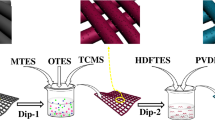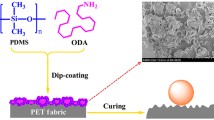Abstract
Durable superamphiphobic surfaces are highly desired for real-world applications such as self-cleaning, anti-fouling, personal protection, and functional sportswear. However, challenges still exist in constructing robust superamphiphobic surfaces by using short-fluorinated polymers as one of the promising alternatives for environmentally unfriendly long perfluorinated side-chain polymers. Hierarchical patterns on biological skins endow the creatures with a specific surface for survival. Here, a facile strategy was proposed to generate hierarchical wrinkles for ultradurable superamphiphobic fabrics by simulating the deformation adaptability of snakeskin. Snake-like hierarchical winkling was constructed by the infusion of reactive perfluorooctyltriethoxysilane (FOS) in a wet chemical plus vapor polymerization process. Upon the infusion of FOS, the mismatch of shrinkage caused by gradient crosslinking leads to the formation of a soft wrinkled poly (perfluorooctyl triethoxysilane) (poly-FOS) surface. Such a snakeskin-like hierarchical wrinkled surface and high fluorine density of poly-FOS endowed the treated superamphiphobic fabrics with high water resistance (contact angle 169°), castor oil resistance (154°), and extraordinary durability (withstanding 100 standard laundries, 15,000 rubbing cycles and strong acid and alkali solutions). Moreover, a superamphiphobic surface can be formed on various substrates, including fabric, wood, paper, and glass. This work thus gives new insights into the environmentally friendly manufacture of ultradurable superamphiphobic fabrics.
Graphical Abstract








Similar content being viewed by others
Data availability statement
The datasets generated during and/or analysed during the current study are available from the corresponding author on reasonable request.
References
Esmaeilzadeh P, Zandi A, Ghazanfari MH, Khezrnejad A, Fatemi M, Molaei DA. Selective fabrication of robust and multifunctional super nonwetting surfaces by diverse modifications of zirconia–ceria nanocomposites. Langmuir 2022;38:9195.
Xie Y, Xiong W, Kareem S, Qiu C, Hu Y, Parkin IP, Wang S, Wang H, Chen J, Li L, Chen Z, Sun H, Zhao X. Robust superamphiphobic coatings with gradient and hierarchical architecture and excellent anti-flashover performances. Nano Res 2022;15:7565.
Jiao X, Li M, Yu X, Yang S, Zhang Y. Mechanically robust superamphiphobic ceramic coatings with releasable nanoparticle-capsules. Chem Eng J 2022;446:137336.
Wu P, Luo Q, Zhang X, He J, Liu C, Jiang W. Universal rapid demulsification by vacuum suction using superamphiphilic and under liquid superamphiphobic polyurethane/diatomite composites. ACS Appl Mater Inter 2022;14:24775.
Jiao L, Tong J, Wu Y, Hu Y, Wu H, Li D, Chen R. Self-assembly of superparticles on a lubricated-superamphiphobic patterned surface. Appl Surf Sci 2022;576:151684.
Wang T, Cui J, Ouyang S, Cui W, Wang S. A new approach to understand the Cassie state of liquids on superamphiphobic materials. Nanoscale 2016;8:3031.
Feng XJ, Jiang L. Design and creation of superwetting/antiwetting surfaces. Adv Mater 2006;18:3063.
Hao Y, Wang L, Liang Y, He B, Zhang Y, Cheng B, Kang W, Deng N. Bifunctional semi-closed YF3-doped 1D carbon nanofibers with 3D porous network structure including fluorinating interphases and polysulfide confinement for lithium-sulfur batteries. Nanoscale 2019;11:21324.
Zhou H, Wang H, Niu H, Gestos A, Wang X, Lin T. Fluoroalkyl silane modified silicone rubber/nanoparticle composite: a super durable, robust superhydrophobic fabric coating. Adv Mater 2012;24:2409.
Yang J, Zhang Z, Xu X, Men X, Zhu X, Zhou X. Superoleophobic textured aluminum surfaces. New J Chem 2011;35:2422.
Yao X, Gao J, Song Y, Jiang L. Superoleophobic surfaces with controllable oil adhesion and their application in oil transportation. Adv Funct Mater 2011;21:4270.
Frøvik N, Greve MM, Helseth LE. Nanostructures and wetting properties controlled by reactive ion etching of fluorinated ethylene propylene. Colloid Surface A 2019;574:228.
Pei M, Huo L, Zhang K, Zhou H, Liu P. Hydrophobic surface via coating fluorinated homopolymer: Effects of the surface etching of silicon wafer and coated fluoropolymer amount. Colloid Surface A 2020;585:123984.
Chang CW, Hsu HH, Hsu CS, Chen JT. Achieving area-selective atomic layer deposition with fluorinated self-assembled monolayers. J Mater Chem C 2021;9:14589.
Stenberg P, Sukkaew P, Farkas I, Kordina O, Janzén E, Ojamäe L, Danielsson Ö, Pedersen H. Silicon chemistry in fluorinated chemical vapor deposition of silicon carbide. The J Phys Chem C 2017;121:2711.
Akiki G, Suchet D, Daineka D, Filonovich S, Bulkin P, Johnson EV. Area selective deposition of silicon by plasma-enhanced chemical vapor deposition using a fluorinated precursor. Appl Surf Sci 2020;531:147305.
Haruki M, Oda A, Wasada A, Kihara S, Takishima S. Deposition of fluorinated polyimide consisting of 6FDA and TFDB into microscale trenches using supercritical carbon dioxide. J Supercrit Fluids 2017;119:238.
Soto D, Ugur A, Farnham TA, Gleason KK, Varanasi KK. Short-fluorinated iCVD coatings for nonwetting fabrics. Adv Funct Mater 2018;28:1707355.
Fujii T, Aoki Y, Habazaki H. Fabrication of super-oil-repellent dual pillar surfaces with optimized pillar intervals. Langmuir 2011;27:11752.
Wong WSY. Surface chemistry enhancements for the tunable super-liquid repellency of low-surface-tension liquids. Nano Lett 2019;19:1892.
Ma M, Mao Y, Gupta M, Gleason KK, Rutledge GC. Superhydrophobic fabrics produced by electrospinning and chemical vapor deposition. Macromolecules 2005;38:9742.
Yoo Y, You JB, Choi W, Im SG. A stacked polymer film for robust superhydrophobic fabrics. Polym Chem 2013;4:1664.
Giesy JP, Kannan K. Global distribution of perfluorooctane sulfonate in wildlife. Environ Sci Technol 2001;35:1339.
Wang N, Szostek B, Buck RC, Folsom PW, Sulecki LM, Gannon JT. 8–2 Fluorotelomer alcohol aerobic soil biodegradation: pathways, metabolites, and metabolite yields. Chemosphere 2009;75:1089.
Zhang Z, Sarkar D, Biswas JK, Datta R. Biodegradation of per- and polyfluoroalkyl substances (PFAS): a review. Bioresource Technol 2022;344:126223.
Chen CE, Yang YY, Zhao JL, Liu YS, Hu LX, Li BB, Li CL, Ying GG. Legacy and alternative per- and polyfluoroalkyl substances (PFASs) in the West River and North River, south China: Occurrence, fate, spatio-temporal variations and potential sources. Chemosphere 2021;283:131301.
Guo J, Resnick P, Efimenko K, Genzer J, DeSimone JM. Alternative fluoropolymers to avoid the challenges associated with perfluorooctanoic acid. Ind Eng Chem Res 2008;47:502.
Zaggia A, Ameduri B. Recent advances on synthesis of potentially non-bioaccumulable fluorinated surfactants. Curr Opin Colloid Interface Sci 2012;17:188.
Darmanin T, Tarrade J, Celia E, Guittard F. Superoleophobic meshes with high adhesion by electrodeposition of conducting polymer containing short perfluorobutyl chains. J Phys Chem C 2014;118:2052.
Honda K, Yamamoto I, Morita M, Yamaguchi H, Arita H, Ishige R, Higaki Y, Takahara A. Effect of α-substituents on molecular motion and wetting behaviors of poly(fluoroalkyl acrylate) thin films with short fluoroalkyl side chains. Polymer 2014;55:6303.
Zhou J, Wang L, Zha X, Li X. Synthesis of Ag/fluorine-containing polyacrylate latex stabilized by Ag nanoparticle hybrid amphiphilic random copolymer micelles via Pickering emulsion polymerization and its application on fabric finishing. Cellulose 2020;27:9123.
Şakalak H, Yılmaz K, Gürsoy M, Karaman M. Roll-to-roll initiated chemical vapor deposition of superhydrophobic thin films on large-scale flexible substrates. Chem Eng Sci 2020;215:115466.
Honda K, Morita M, Otsuka H, Takahara A. Molecular aggregation structure and surface properties of poly(fluoroalkyl acrylate) thin films. Macromolecules 2005;38:5699.
Honda K, Morita M, Sakata O, Sasaki S, Takahara A. Effect of surface molecular aggregation state and surface molecular motion on wetting behavior of water on poly(fluoroalkyl methacrylate) thin films. Macromolecules 2010;43:454.
Quéré D. Wetting and roughness. Annu Rev Mater Res 2008;38:71.
Tan Y, Hu B, Song J, Chu Z, Wu W. Bioinspired multiscale wrinkling patterns on curved substrates: An overview. Nano-Micro Lett 2020;12:101.
Xu L, Yang L, Yang S, Xu Z, Lin G, Shi J, Zhang R, Yu J, Ge D, Guo Y. Earthworm-inspired ultradurable superhydrophobic fabrics from adaptive wrinkled skin. ACS Appl Mater Inter 2021;13:6758.
Ahn J, Zhao ZJ, Choi J, Jeong Y, Hwang S, Ko J, Gu J, Jeon S, Park J, Kang M, Del Orbe DV, Cho I, Kang H, Bok M, Jeong J-H, Park I. Morphology-controllable wrinkled hierarchical structure and its application to superhydrophobic triboelectric nanogenerator. Nano Energy 2021;85:105978.
Hönes R, Kondrashov V, Rühe J. Molting materials: Restoring superhydrophobicity after severe damage via snakeskin-like shedding. Langmuir 2017;33:4833.
Liu P, Liu S, Yu X, Zhang Y. Silane-triggered fabrication of stable waterborne superamphiphobic coatings. Chem Eng J 2021;406:127153.
Bourget L, Mutin PH, Vioux A, Frances JM. Nonhydrolytic synthesis and structural study of methoxyl-terminated polysiloxane D/Q resins. J Polym Sci Pol Chem 1998;36:2415.
Zhou H, Wang H, Niu H, Zhao Y, Xu Z, Lin T. A waterborne coating system for preparing robust, self-healing, superamphiphobic surfaces. Adv Funct Mater 2017;27:1604261.
Protsak IS, Morozov YM, Dong W, Le Z, Zhang D, Henderson IM. A 29Si, 1H, and 13C solid-state NMR study on the surface species of various depolymerized organosiloxanes at silica surface. Nanoscale Res Lett 2019;14:160.
Liu S, Zhou H, Wang H, Yang W, Shao H, Fu S, Zhao Y, Liu D, Feng Z, Lin T. Argon-plasma reinforced superamphiphobic fabrics. Small 2017;13:1701891.
Hou Y, Zhu G, Cui J, Wu N, Zhao B, Xu J, Zhao N. Superior hard but quickly reversible Si–O–Si network enables scalable fabrication of transparent, self-healing, robust, and programmable multifunctional nanocomposite coatings. J Am Chem Soc 2022;144:436.
Zhong Y, Huang P, Yan W, Su Z, Sun C, Xing Y, Lai C. Ion-Conductive Polytitanosiloxane Networks Enable a Robust Solid-Electrolyte Interface for Long-Cycling Lithium Metal Anodes. Adv Funct Mater 2022;32:2110347.
Li Y, Peterson JJ, Jhaveri SB, Carter KR. Patterned polymer films via reactive silane infusion-induced wrinkling. Langmuir 2013;29:4632.
Wang D, Xu L, Zhang L, Zhang L, Zhang A. Hydrophobic/superhydrophobic reversible smart materials via photo/thermo dual-response dynamic wrinkled structure. Chem Eng J 2021;420:127679.
Li Y, Dai S, John J, Carter KR. Superhydrophobic surfaces from hierarchically structured wrinkled polymers. ACS Appl Mater Inter 2013;5:11066.
Liu H, Zhang S, Li Z, Lu TJ, Lin H, Zhu Y, Ahadian S, Emaminejad S, Dokmeci MR, Xu F, Khademhosseini A. Harnessing the wide-range strain sensitivity of bilayered PEDOT: PSS films for wearable health monitoring. Matter 2021;4:2886.
Wang H, Xue Y, Ding J, Feng L, Wang X, Lin T. Durable, self-healing superhydrophobic and superoleophobic surfaces from fluorinated-decyl polyhedral oligomeric silsesquioxane and hydrolyzed fluorinated alkyl silane. Angew Chem Int Edit 2011;50:11433.
Zhou H, Wang H, Niu H, Gestos A, Lin T. Robust, self-healing superamphiphobic fabrics prepared by two-step coating of fluoro-containing polymer, fluoroalkyl silane, and modified silica nanoparticles. Adv Funct Mater 2012;23:1664.
Chen J, Zhong X, Jing L, Wyman I, Xu W. The facile preparation of self-cleaning fabrics. Compos Sci Technol 2015;122:1.
Zhou X, Sun S, Zhang C, Wang XY, Jiang Y. Facile fabrication of durable superamphiphobic PET fabrics. J Coat Technol Res 2019;17:711.
Qu M, Ma X, Hou L, Yuan M, He J, Xue M, Liu X, He J. Fabrication of durable superamphiphobic materials on various substrates with wear-resistance and self-cleaning performance from kaolin. Appl Surf Sci 2018;456:737.
Tian N, Chen K, Wei J, Zhang J. Robust superamphiphobic fabrics with excellent hot liquid repellency and hot water vapor resistance. Langmuir 2022;38:5891.
Acknowledgements
The authors gratefully acknowledge the financial support of the National Natural Science Foundation of China (52073046, 51873036, 51673039, and 52103106), the Program of Shanghai Academic Leader (21XD1420200), the Chang Jiang Scholar Program (Q2019152) and the Shanghai Shuguang Program (19SG28).
Author information
Authors and Affiliations
Corresponding authors
Ethics declarations
Conflicts of Interest
The authors declare no conflicts of interest.
Additional information
Publisher's Note
Springer Nature remains neutral with regard to jurisdictional claims in published maps and institutional affiliations.
Supplementary Information
Below is the link to the electronic supplementary material.
Supplementary file2 (MP4 69319 KB)
Supplementary file3 (MP4 662 KB)
Supplementary file4 (MP4 3468 KB)
Supplementary file5 (MP4 2283 KB)
Rights and permissions
Springer Nature or its licensor (e.g. a society or other partner) holds exclusive rights to this article under a publishing agreement with the author(s) or other rightsholder(s); author self-archiving of the accepted manuscript version of this article is solely governed by the terms of such publishing agreement and applicable law.
About this article
Cite this article
Yu, M., Lyu, W., Liao, Y. et al. Snakeskin-Inspired Hierarchical Winkled Surface for Ultradurable Superamphiphobic Fabrics via Short-Fluorinated Polymer Reactive Infusion. Adv. Fiber Mater. 5, 543–553 (2023). https://doi.org/10.1007/s42765-022-00240-w
Received:
Accepted:
Published:
Issue Date:
DOI: https://doi.org/10.1007/s42765-022-00240-w




